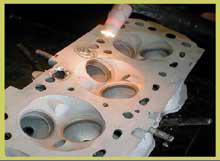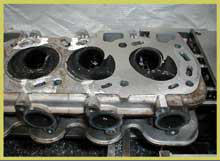























Head engine problem Brisbane - CORROSION
Have you heard the term "stray currents"? What about the product "glycol"? What about "erosion"? What about "corrosion"? What about "pH reading"? Corroded alloy cylinder heads have become accepted as normal in the automotive trade. With correct and consistent maintenance the problem could be drastically reduced. When welding and repairing these alloy heads it is very evident that all manufacturers use different standards when manufacturing their cylinder heads. The choice of the aluminium castings are of all qualities. Some alloy heads are easier to weld than others and appear to be more resistant to corrosion. Other alloy heads commonly suffer severe corrosion problems. Irrespective of the quality of the alloy casting used by manufacturers, corrosion can be controlled by the correct maintenance procedures. The quality or choice of the alloy casting is evident when the service procedures are not adhered to. A good alloy casting will be more resistant to corrosion under harsh conditions. Stray currents are a problem with use of DC power. The general description of stray currents is when the current takes an alternate path back to the negative battery terminal. This happens when the earth system is inadequate. In the case of automotive engines some of the return current uses the coolant and cylinder head structure as its path back to the negative pole. This causes stray current erosion and is generally evident when a perfectly good casting has one or two isolated points of erosion. All earth contact points have to be maintained. Extra earth wires should be attached to the affected component and the negative battery terminal. The best protection is to chemically coat the casting. This is achieved by the use of specially formulated inhibitors being maintained in the cooling system at all times. These inhibitors put a protective coating over the entire water jacket and offer the best protection available. Glycol will increase the boiling point and reduce the freezing point of the coolant. The strength and integrity of the coolant in the system has to be maintained at the correct level to enable the best possible corrosion and erosion protection. Glycol is required to control hot spot boiling. pH readings with test strips should be part of the service procedure to maintain the coolant at the manufacturers recommended level. A good quality coolant has about 33% to 50% glycol along with other anti-corrosive agents. (This 33% to 50% glycol level is what is required in the mixed coolant so use care to calculate what ratio of water and coolant maintains this level. Coolants should be mixed at the recommended ratios with good quality de-mineralised water. Disclaimer Agreement : Every care has been taken in writing this information and procedures, but no responsibility can be excepted for errors, omissions or misuse of this information and procedures. The information available on this site is for your instruction only and cannot be copied for sale, © copyright 2001 UMR Engines


Welding cylinder head
& waterways
Welding corrosion in
head
Welded & milling head





















•
Queensland Transport Authorised to approve LA1,LA3,LB1,LD1-2,LK1,LK6 Modification’s to light vehicles
•
LPG Approved Workshop
•
RWC Licence
•
RACQ Approved Automotive Repairer




Head engine problem Brisbane -
CORROSION
Have you heard the term "stray currents"? What about the product "glycol"? What about "erosion"? What about "corrosion"? What about "pH reading"? Corroded alloy cylinder heads have become accepted as normal in the automotive trade. With correct and consistent maintenance the problem could be drastically reduced. When welding and repairing these alloy heads it is very evident that all manufacturers use different standards when manufacturing their cylinder heads. The choice of the aluminium castings are of all qualities. Some alloy heads are easier to weld than others and appear to be more resistant to corrosion. Other alloy heads commonly suffer severe corrosion problems. Irrespective of the quality of the alloy casting used by manufacturers, corrosion can be controlled by the correct maintenance procedures. The quality or choice of the alloy casting is evident when the service procedures are not adhered to. A good alloy casting will be more resistant to corrosion under harsh conditions. Stray currents are a problem with use of DC power. The general description of stray currents is when the current takes an alternate path back to the negative battery terminal. This happens when the earth system is inadequate. In the case of automotive engines some of the return current uses the coolant and cylinder head structure as its path back to the negative pole. This causes stray current erosion and is generally evident when a perfectly good casting has one or two isolated points of erosion. All earth contact points have to be maintained. Extra earth wires should be attached to the affected component and the negative battery terminal. The best protection is to chemically coat the casting. This is achieved by the use of specially formulated inhibitors being maintained in the cooling system at all times. These inhibitors put a protective coating over the entire water jacket and offer the best protection available. Glycol will increase the boiling point and reduce the freezing point of the coolant. The strength and integrity of the coolant in the system has to be maintained at the correct level to enable the best possible corrosion and erosion protection. Glycol is required to control hot spot boiling. pH readings with test strips should be part of the service procedure to maintain the coolant at the manufacturers recommended level. A good quality coolant has about 33% to 50% glycol along with other anti-corrosive agents. (This 33% to 50% glycol level is what is required in the mixed coolant so use care to calculate what ratio of water and coolant maintains this level. Coolants should be mixed at the recommended ratios with good quality de- mineralised water. Disclaimer Agreement : Every care has been taken in writing this information and procedures, but no responsibility can be excepted for errors, omissions or misuse of this information and procedures. The information available on this site is for your instruction only and cannot be copied for sale, © copyright 2001 UMR Engines


Welding cylinder head
& waterways
Welding corrosion in
head
Welded & milling head





7 Moss Street, Slacks Creek, Qld 4127




































